Investigating the Internet of Things Role in Crime Detection & Law
VerifiedAdded on 2023/06/05
|20
|5834
|87
Report
AI Summary
This report explores the role of the Internet of Things (IoT) in crime detection and mitigation, addressing the increasing challenges of cybercrime and public safety. Part A outlines the thesis, research problems, and dissertation structure, including an introduction, literature review, research methodology, data analysis, and conclusion. The literature review examines existing views on IoT's role in crime prevention, focusing on applications like biometric identification, alcohol content sensing, copper theft detection, and school safety measures using perimeter security and CCTV cameras. Part B details the research methodology, including the descriptive research design, research questions, hypotheses, data collection methods, and sampling techniques. The report concludes by discussing the researcher's self-understanding and learning throughout the research process. Desklib provides access to similar solved assignments and resources for students.
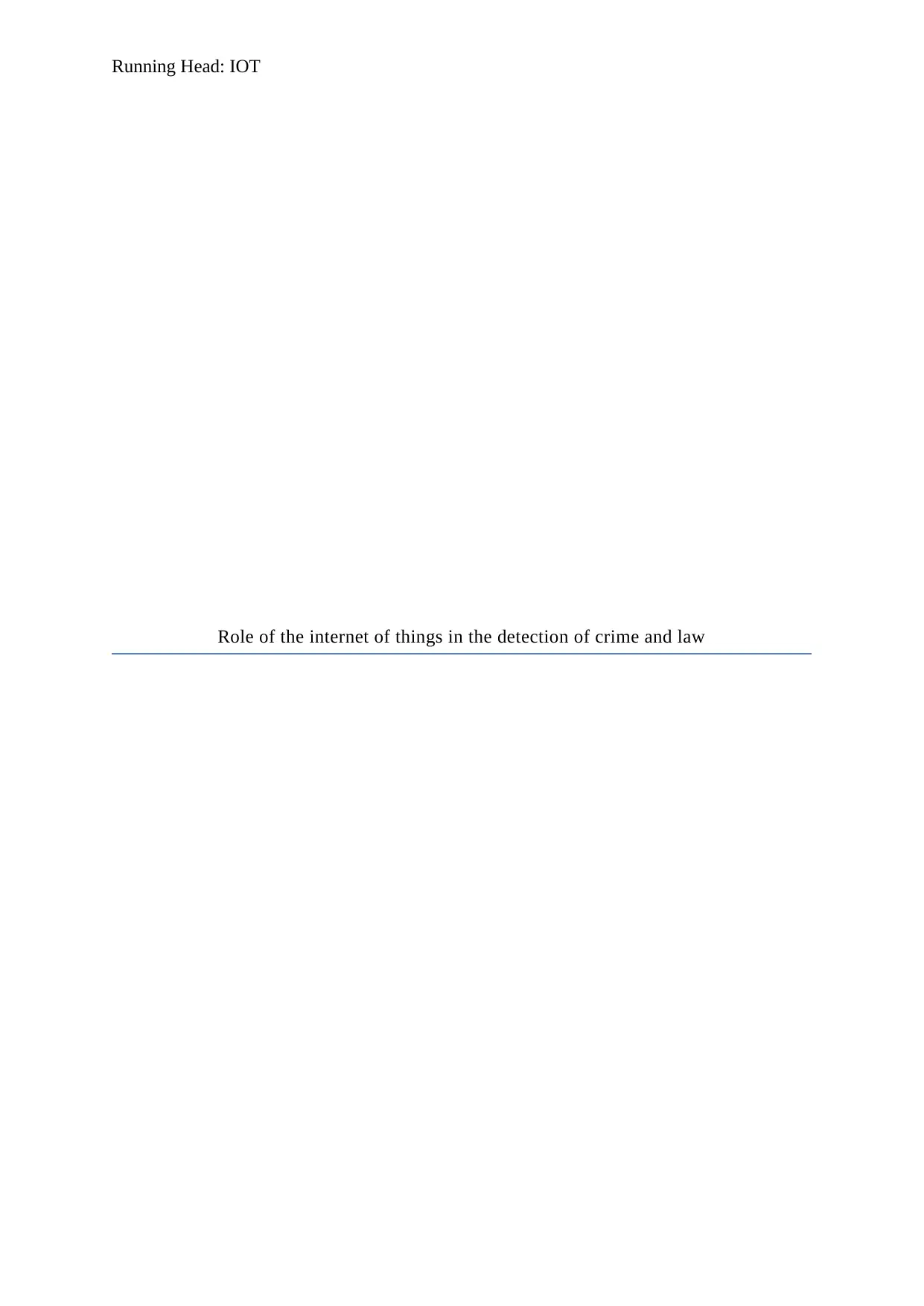
Running Head: IOT
Role of the internet of things in the detection of crime and law
Role of the internet of things in the detection of crime and law
Paraphrase This Document
Need a fresh take? Get an instant paraphrase of this document with our AI Paraphraser
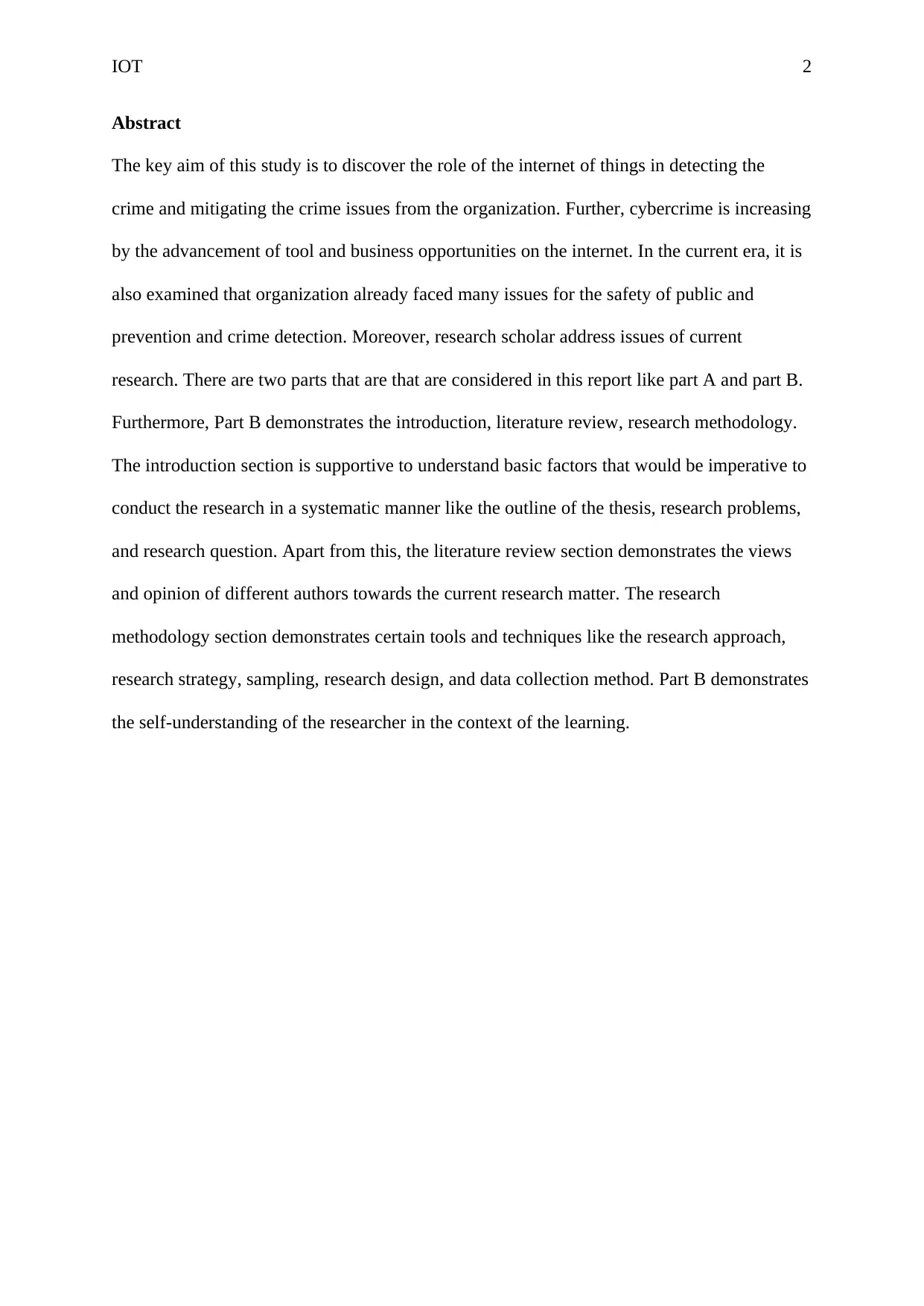
IOT 2
Abstract
The key aim of this study is to discover the role of the internet of things in detecting the
crime and mitigating the crime issues from the organization. Further, cybercrime is increasing
by the advancement of tool and business opportunities on the internet. In the current era, it is
also examined that organization already faced many issues for the safety of public and
prevention and crime detection. Moreover, research scholar address issues of current
research. There are two parts that are that are considered in this report like part A and part B.
Furthermore, Part B demonstrates the introduction, literature review, research methodology.
The introduction section is supportive to understand basic factors that would be imperative to
conduct the research in a systematic manner like the outline of the thesis, research problems,
and research question. Apart from this, the literature review section demonstrates the views
and opinion of different authors towards the current research matter. The research
methodology section demonstrates certain tools and techniques like the research approach,
research strategy, sampling, research design, and data collection method. Part B demonstrates
the self-understanding of the researcher in the context of the learning.
Abstract
The key aim of this study is to discover the role of the internet of things in detecting the
crime and mitigating the crime issues from the organization. Further, cybercrime is increasing
by the advancement of tool and business opportunities on the internet. In the current era, it is
also examined that organization already faced many issues for the safety of public and
prevention and crime detection. Moreover, research scholar address issues of current
research. There are two parts that are that are considered in this report like part A and part B.
Furthermore, Part B demonstrates the introduction, literature review, research methodology.
The introduction section is supportive to understand basic factors that would be imperative to
conduct the research in a systematic manner like the outline of the thesis, research problems,
and research question. Apart from this, the literature review section demonstrates the views
and opinion of different authors towards the current research matter. The research
methodology section demonstrates certain tools and techniques like the research approach,
research strategy, sampling, research design, and data collection method. Part B demonstrates
the self-understanding of the researcher in the context of the learning.
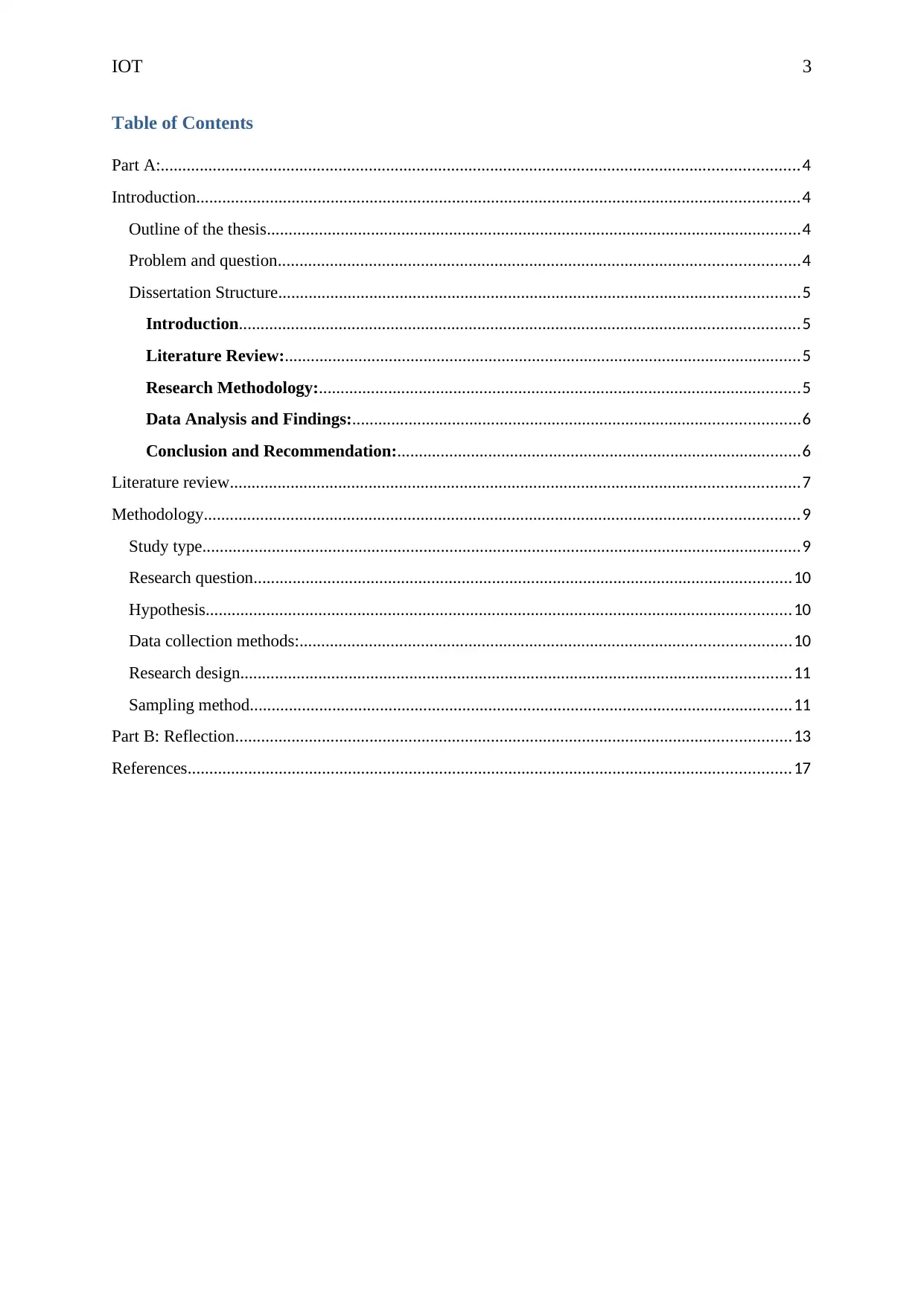
IOT 3
Table of Contents
Part A:...................................................................................................................................................4
Introduction...........................................................................................................................................4
Outline of the thesis...........................................................................................................................4
Problem and question........................................................................................................................4
Dissertation Structure........................................................................................................................5
Introduction.................................................................................................................................5
Literature Review:.......................................................................................................................5
Research Methodology:...............................................................................................................5
Data Analysis and Findings:.......................................................................................................6
Conclusion and Recommendation:.............................................................................................6
Literature review...................................................................................................................................7
Methodology.........................................................................................................................................9
Study type..........................................................................................................................................9
Research question............................................................................................................................10
Hypothesis.......................................................................................................................................10
Data collection methods:.................................................................................................................10
Research design...............................................................................................................................11
Sampling method.............................................................................................................................11
Part B: Reflection................................................................................................................................13
References...........................................................................................................................................17
Table of Contents
Part A:...................................................................................................................................................4
Introduction...........................................................................................................................................4
Outline of the thesis...........................................................................................................................4
Problem and question........................................................................................................................4
Dissertation Structure........................................................................................................................5
Introduction.................................................................................................................................5
Literature Review:.......................................................................................................................5
Research Methodology:...............................................................................................................5
Data Analysis and Findings:.......................................................................................................6
Conclusion and Recommendation:.............................................................................................6
Literature review...................................................................................................................................7
Methodology.........................................................................................................................................9
Study type..........................................................................................................................................9
Research question............................................................................................................................10
Hypothesis.......................................................................................................................................10
Data collection methods:.................................................................................................................10
Research design...............................................................................................................................11
Sampling method.............................................................................................................................11
Part B: Reflection................................................................................................................................13
References...........................................................................................................................................17
⊘ This is a preview!⊘
Do you want full access?
Subscribe today to unlock all pages.

Trusted by 1+ million students worldwide
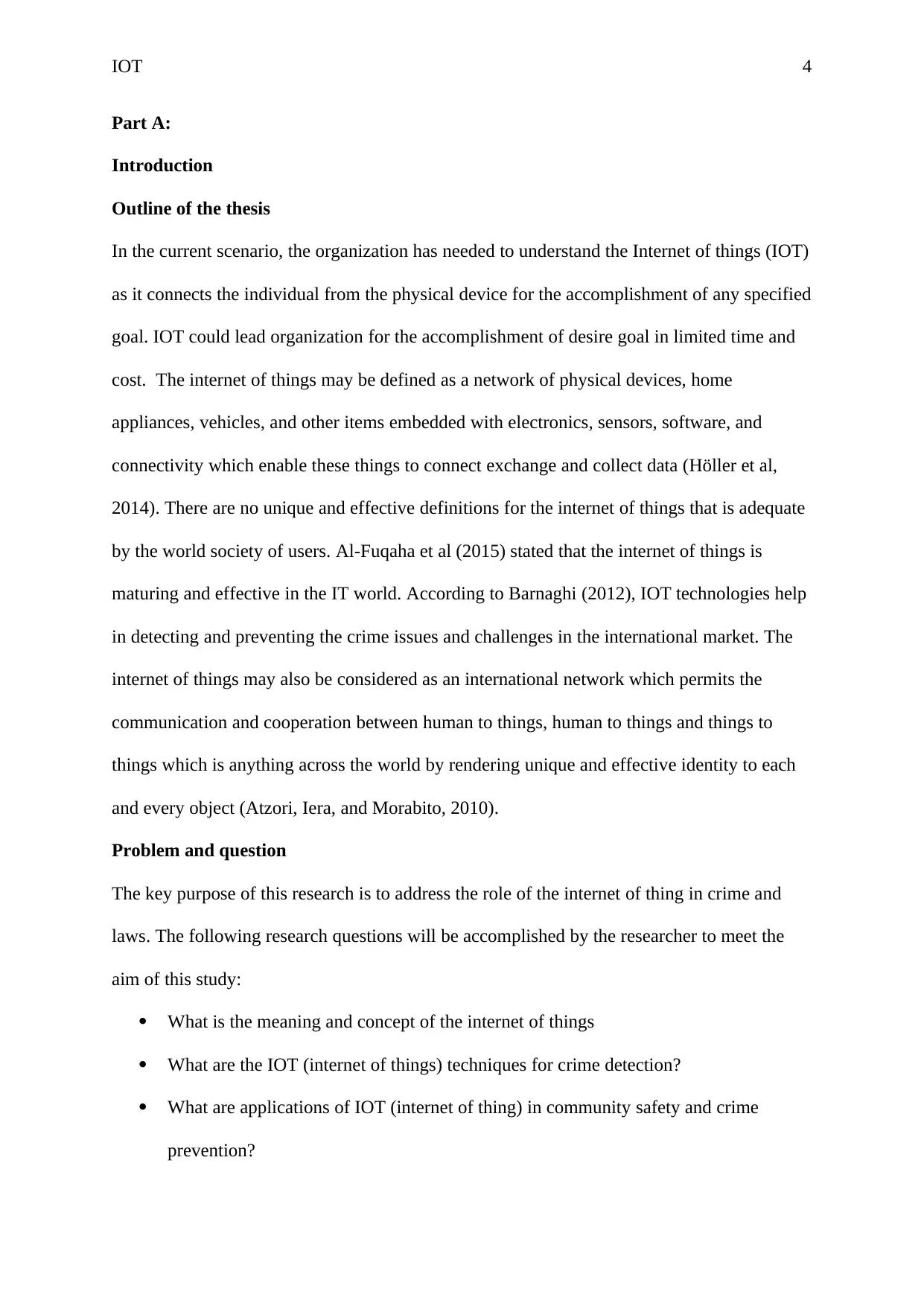
IOT 4
Part A:
Introduction
Outline of the thesis
In the current scenario, the organization has needed to understand the Internet of things (IOT)
as it connects the individual from the physical device for the accomplishment of any specified
goal. IOT could lead organization for the accomplishment of desire goal in limited time and
cost. The internet of things may be defined as a network of physical devices, home
appliances, vehicles, and other items embedded with electronics, sensors, software, and
connectivity which enable these things to connect exchange and collect data (Höller et al,
2014). There are no unique and effective definitions for the internet of things that is adequate
by the world society of users. Al-Fuqaha et al (2015) stated that the internet of things is
maturing and effective in the IT world. According to Barnaghi (2012), IOT technologies help
in detecting and preventing the crime issues and challenges in the international market. The
internet of things may also be considered as an international network which permits the
communication and cooperation between human to things, human to things and things to
things which is anything across the world by rendering unique and effective identity to each
and every object (Atzori, Iera, and Morabito, 2010).
Problem and question
The key purpose of this research is to address the role of the internet of thing in crime and
laws. The following research questions will be accomplished by the researcher to meet the
aim of this study:
What is the meaning and concept of the internet of things
What are the IOT (internet of things) techniques for crime detection?
What are applications of IOT (internet of thing) in community safety and crime
prevention?
Part A:
Introduction
Outline of the thesis
In the current scenario, the organization has needed to understand the Internet of things (IOT)
as it connects the individual from the physical device for the accomplishment of any specified
goal. IOT could lead organization for the accomplishment of desire goal in limited time and
cost. The internet of things may be defined as a network of physical devices, home
appliances, vehicles, and other items embedded with electronics, sensors, software, and
connectivity which enable these things to connect exchange and collect data (Höller et al,
2014). There are no unique and effective definitions for the internet of things that is adequate
by the world society of users. Al-Fuqaha et al (2015) stated that the internet of things is
maturing and effective in the IT world. According to Barnaghi (2012), IOT technologies help
in detecting and preventing the crime issues and challenges in the international market. The
internet of things may also be considered as an international network which permits the
communication and cooperation between human to things, human to things and things to
things which is anything across the world by rendering unique and effective identity to each
and every object (Atzori, Iera, and Morabito, 2010).
Problem and question
The key purpose of this research is to address the role of the internet of thing in crime and
laws. The following research questions will be accomplished by the researcher to meet the
aim of this study:
What is the meaning and concept of the internet of things
What are the IOT (internet of things) techniques for crime detection?
What are applications of IOT (internet of thing) in community safety and crime
prevention?
Paraphrase This Document
Need a fresh take? Get an instant paraphrase of this document with our AI Paraphraser
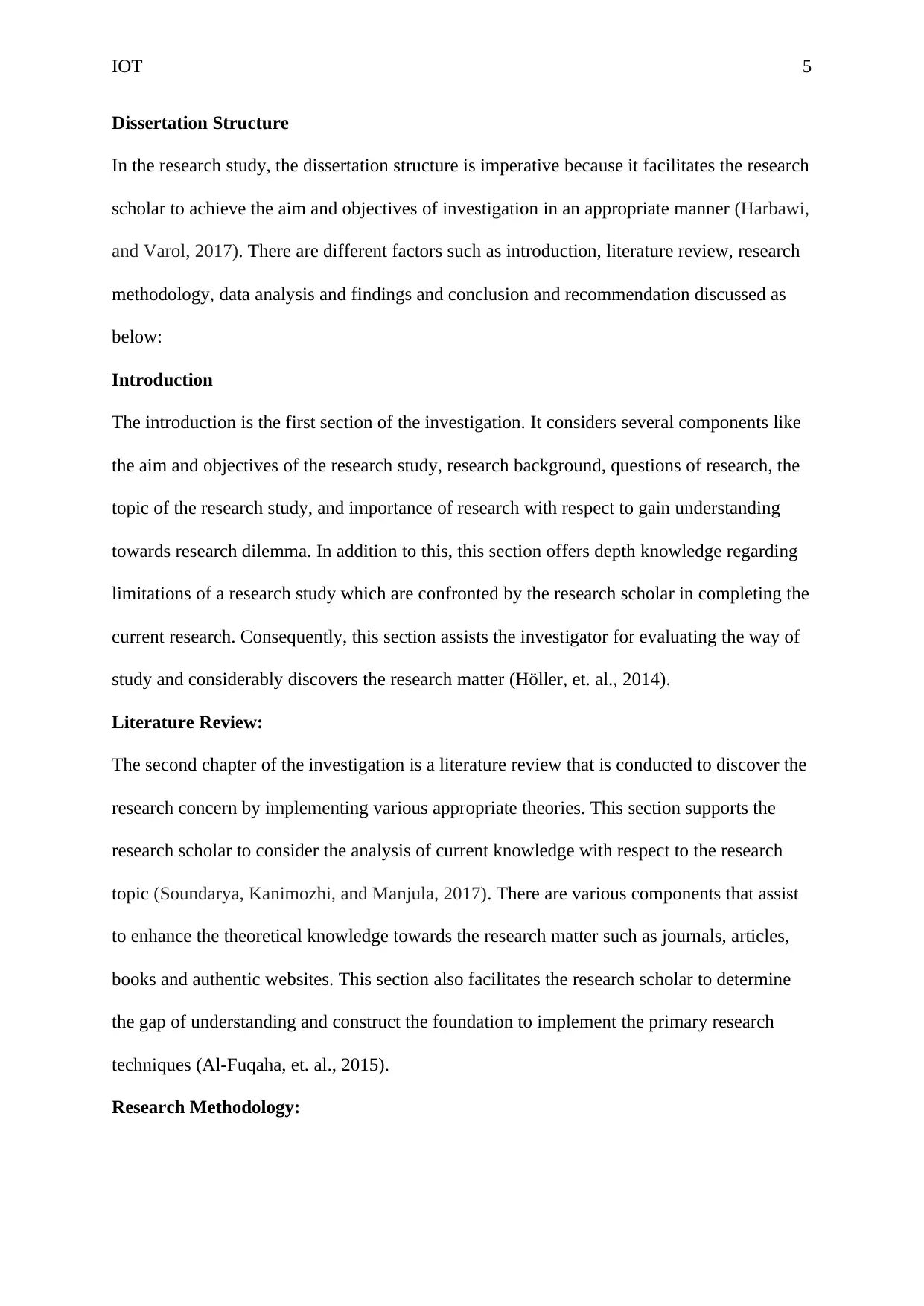
IOT 5
Dissertation Structure
In the research study, the dissertation structure is imperative because it facilitates the research
scholar to achieve the aim and objectives of investigation in an appropriate manner (Harbawi,
and Varol, 2017). There are different factors such as introduction, literature review, research
methodology, data analysis and findings and conclusion and recommendation discussed as
below:
Introduction
The introduction is the first section of the investigation. It considers several components like
the aim and objectives of the research study, research background, questions of research, the
topic of the research study, and importance of research with respect to gain understanding
towards research dilemma. In addition to this, this section offers depth knowledge regarding
limitations of a research study which are confronted by the research scholar in completing the
current research. Consequently, this section assists the investigator for evaluating the way of
study and considerably discovers the research matter (Höller, et. al., 2014).
Literature Review:
The second chapter of the investigation is a literature review that is conducted to discover the
research concern by implementing various appropriate theories. This section supports the
research scholar to consider the analysis of current knowledge with respect to the research
topic (Soundarya, Kanimozhi, and Manjula, 2017). There are various components that assist
to enhance the theoretical knowledge towards the research matter such as journals, articles,
books and authentic websites. This section also facilitates the research scholar to determine
the gap of understanding and construct the foundation to implement the primary research
techniques (Al-Fuqaha, et. al., 2015).
Research Methodology:
Dissertation Structure
In the research study, the dissertation structure is imperative because it facilitates the research
scholar to achieve the aim and objectives of investigation in an appropriate manner (Harbawi,
and Varol, 2017). There are different factors such as introduction, literature review, research
methodology, data analysis and findings and conclusion and recommendation discussed as
below:
Introduction
The introduction is the first section of the investigation. It considers several components like
the aim and objectives of the research study, research background, questions of research, the
topic of the research study, and importance of research with respect to gain understanding
towards research dilemma. In addition to this, this section offers depth knowledge regarding
limitations of a research study which are confronted by the research scholar in completing the
current research. Consequently, this section assists the investigator for evaluating the way of
study and considerably discovers the research matter (Höller, et. al., 2014).
Literature Review:
The second chapter of the investigation is a literature review that is conducted to discover the
research concern by implementing various appropriate theories. This section supports the
research scholar to consider the analysis of current knowledge with respect to the research
topic (Soundarya, Kanimozhi, and Manjula, 2017). There are various components that assist
to enhance the theoretical knowledge towards the research matter such as journals, articles,
books and authentic websites. This section also facilitates the research scholar to determine
the gap of understanding and construct the foundation to implement the primary research
techniques (Al-Fuqaha, et. al., 2015).
Research Methodology:
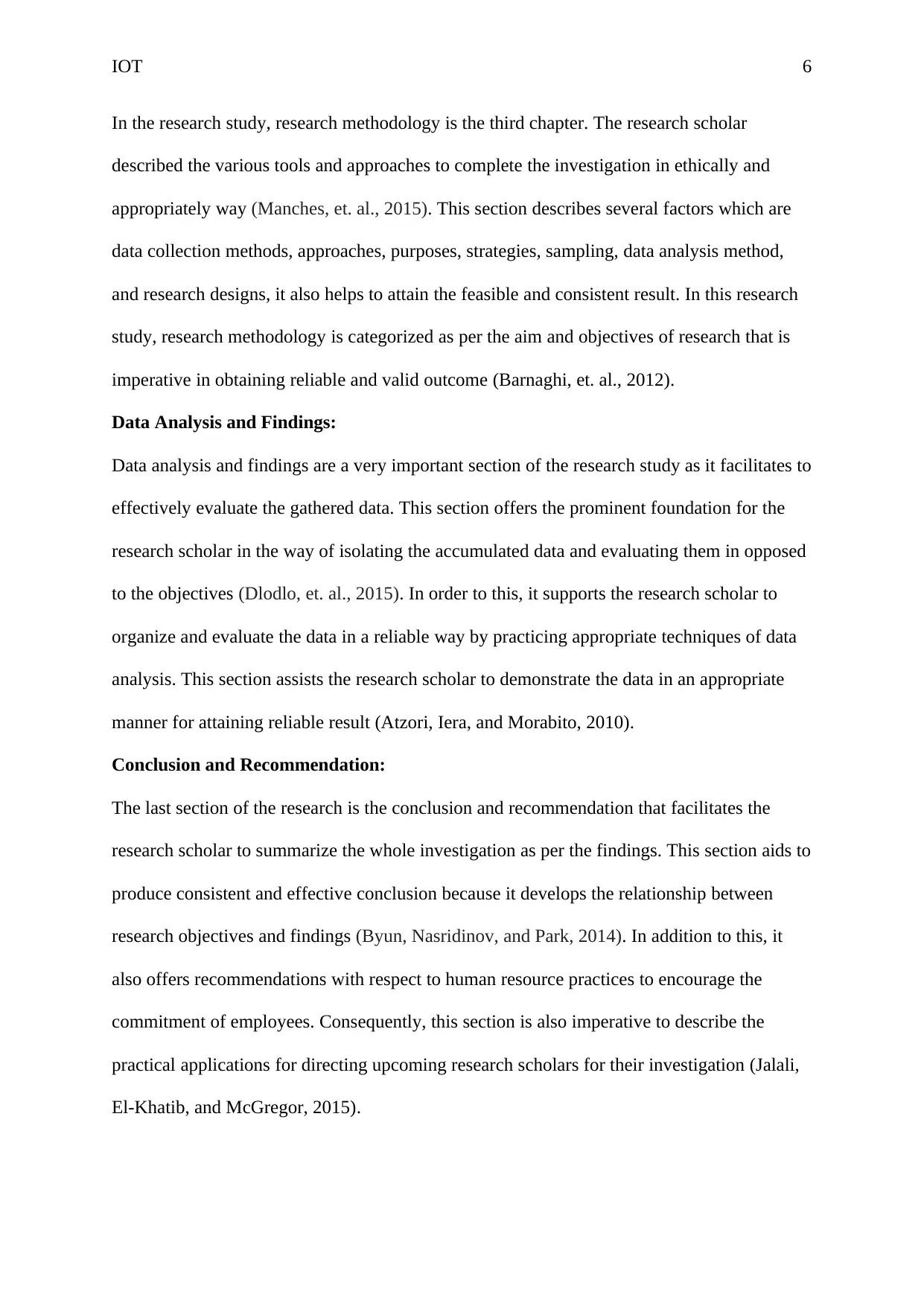
IOT 6
In the research study, research methodology is the third chapter. The research scholar
described the various tools and approaches to complete the investigation in ethically and
appropriately way (Manches, et. al., 2015). This section describes several factors which are
data collection methods, approaches, purposes, strategies, sampling, data analysis method,
and research designs, it also helps to attain the feasible and consistent result. In this research
study, research methodology is categorized as per the aim and objectives of research that is
imperative in obtaining reliable and valid outcome (Barnaghi, et. al., 2012).
Data Analysis and Findings:
Data analysis and findings are a very important section of the research study as it facilitates to
effectively evaluate the gathered data. This section offers the prominent foundation for the
research scholar in the way of isolating the accumulated data and evaluating them in opposed
to the objectives (Dlodlo, et. al., 2015). In order to this, it supports the research scholar to
organize and evaluate the data in a reliable way by practicing appropriate techniques of data
analysis. This section assists the research scholar to demonstrate the data in an appropriate
manner for attaining reliable result (Atzori, Iera, and Morabito, 2010).
Conclusion and Recommendation:
The last section of the research is the conclusion and recommendation that facilitates the
research scholar to summarize the whole investigation as per the findings. This section aids to
produce consistent and effective conclusion because it develops the relationship between
research objectives and findings (Byun, Nasridinov, and Park, 2014). In addition to this, it
also offers recommendations with respect to human resource practices to encourage the
commitment of employees. Consequently, this section is also imperative to describe the
practical applications for directing upcoming research scholars for their investigation (Jalali,
El-Khatib, and McGregor, 2015).
In the research study, research methodology is the third chapter. The research scholar
described the various tools and approaches to complete the investigation in ethically and
appropriately way (Manches, et. al., 2015). This section describes several factors which are
data collection methods, approaches, purposes, strategies, sampling, data analysis method,
and research designs, it also helps to attain the feasible and consistent result. In this research
study, research methodology is categorized as per the aim and objectives of research that is
imperative in obtaining reliable and valid outcome (Barnaghi, et. al., 2012).
Data Analysis and Findings:
Data analysis and findings are a very important section of the research study as it facilitates to
effectively evaluate the gathered data. This section offers the prominent foundation for the
research scholar in the way of isolating the accumulated data and evaluating them in opposed
to the objectives (Dlodlo, et. al., 2015). In order to this, it supports the research scholar to
organize and evaluate the data in a reliable way by practicing appropriate techniques of data
analysis. This section assists the research scholar to demonstrate the data in an appropriate
manner for attaining reliable result (Atzori, Iera, and Morabito, 2010).
Conclusion and Recommendation:
The last section of the research is the conclusion and recommendation that facilitates the
research scholar to summarize the whole investigation as per the findings. This section aids to
produce consistent and effective conclusion because it develops the relationship between
research objectives and findings (Byun, Nasridinov, and Park, 2014). In addition to this, it
also offers recommendations with respect to human resource practices to encourage the
commitment of employees. Consequently, this section is also imperative to describe the
practical applications for directing upcoming research scholars for their investigation (Jalali,
El-Khatib, and McGregor, 2015).
⊘ This is a preview!⊘
Do you want full access?
Subscribe today to unlock all pages.

Trusted by 1+ million students worldwide
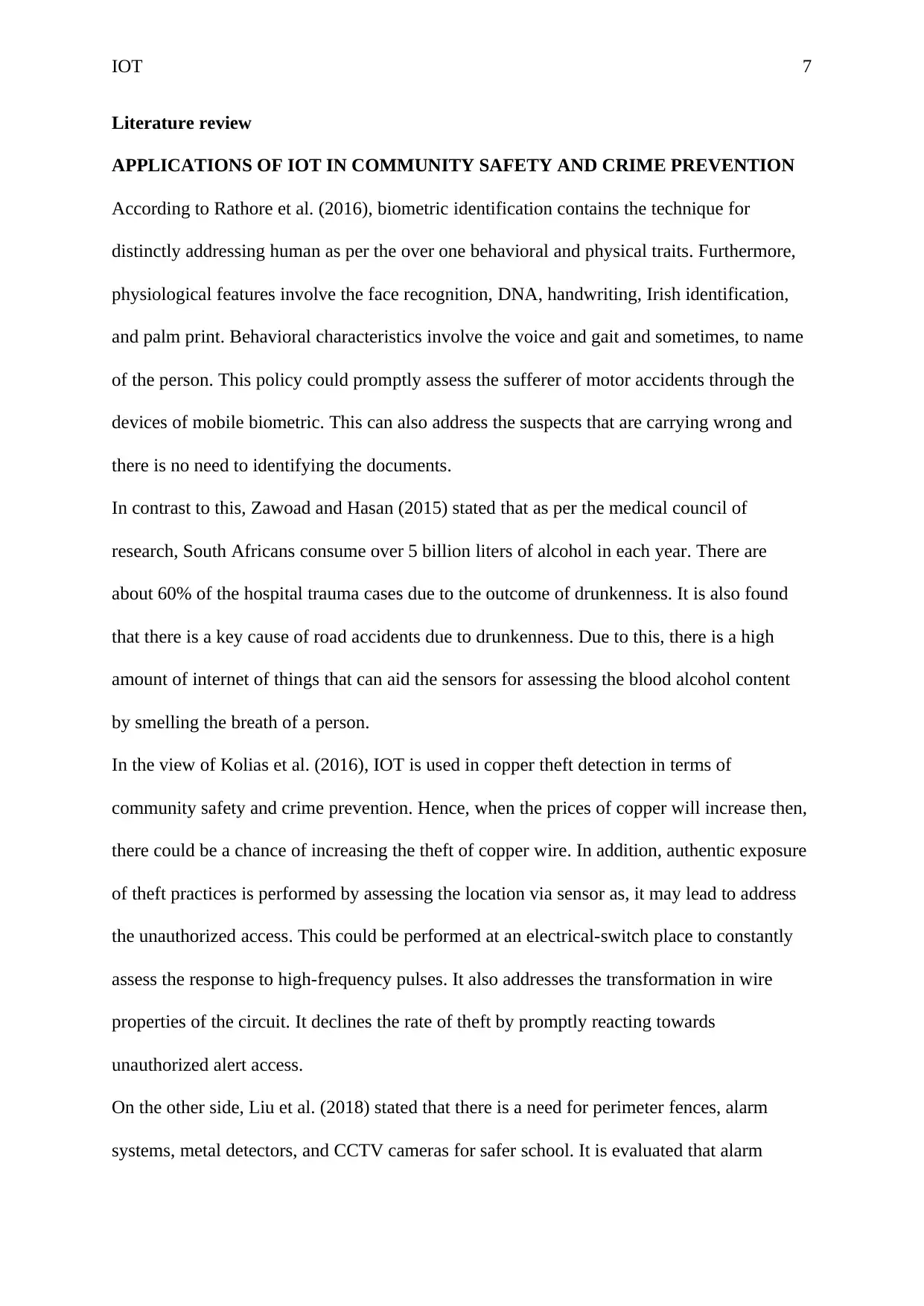
IOT 7
Literature review
APPLICATIONS OF IOT IN COMMUNITY SAFETY AND CRIME PREVENTION
According to Rathore et al. (2016), biometric identification contains the technique for
distinctly addressing human as per the over one behavioral and physical traits. Furthermore,
physiological features involve the face recognition, DNA, handwriting, Irish identification,
and palm print. Behavioral characteristics involve the voice and gait and sometimes, to name
of the person. This policy could promptly assess the sufferer of motor accidents through the
devices of mobile biometric. This can also address the suspects that are carrying wrong and
there is no need to identifying the documents.
In contrast to this, Zawoad and Hasan (2015) stated that as per the medical council of
research, South Africans consume over 5 billion liters of alcohol in each year. There are
about 60% of the hospital trauma cases due to the outcome of drunkenness. It is also found
that there is a key cause of road accidents due to drunkenness. Due to this, there is a high
amount of internet of things that can aid the sensors for assessing the blood alcohol content
by smelling the breath of a person.
In the view of Kolias et al. (2016), IOT is used in copper theft detection in terms of
community safety and crime prevention. Hence, when the prices of copper will increase then,
there could be a chance of increasing the theft of copper wire. In addition, authentic exposure
of theft practices is performed by assessing the location via sensor as, it may lead to address
the unauthorized access. This could be performed at an electrical-switch place to constantly
assess the response to high-frequency pulses. It also addresses the transformation in wire
properties of the circuit. It declines the rate of theft by promptly reacting towards
unauthorized alert access.
On the other side, Liu et al. (2018) stated that there is a need for perimeter fences, alarm
systems, metal detectors, and CCTV cameras for safer school. It is evaluated that alarm
Literature review
APPLICATIONS OF IOT IN COMMUNITY SAFETY AND CRIME PREVENTION
According to Rathore et al. (2016), biometric identification contains the technique for
distinctly addressing human as per the over one behavioral and physical traits. Furthermore,
physiological features involve the face recognition, DNA, handwriting, Irish identification,
and palm print. Behavioral characteristics involve the voice and gait and sometimes, to name
of the person. This policy could promptly assess the sufferer of motor accidents through the
devices of mobile biometric. This can also address the suspects that are carrying wrong and
there is no need to identifying the documents.
In contrast to this, Zawoad and Hasan (2015) stated that as per the medical council of
research, South Africans consume over 5 billion liters of alcohol in each year. There are
about 60% of the hospital trauma cases due to the outcome of drunkenness. It is also found
that there is a key cause of road accidents due to drunkenness. Due to this, there is a high
amount of internet of things that can aid the sensors for assessing the blood alcohol content
by smelling the breath of a person.
In the view of Kolias et al. (2016), IOT is used in copper theft detection in terms of
community safety and crime prevention. Hence, when the prices of copper will increase then,
there could be a chance of increasing the theft of copper wire. In addition, authentic exposure
of theft practices is performed by assessing the location via sensor as, it may lead to address
the unauthorized access. This could be performed at an electrical-switch place to constantly
assess the response to high-frequency pulses. It also addresses the transformation in wire
properties of the circuit. It declines the rate of theft by promptly reacting towards
unauthorized alert access.
On the other side, Liu et al. (2018) stated that there is a need for perimeter fences, alarm
systems, metal detectors, and CCTV cameras for safer school. It is evaluated that alarm
Paraphrase This Document
Need a fresh take? Get an instant paraphrase of this document with our AI Paraphraser
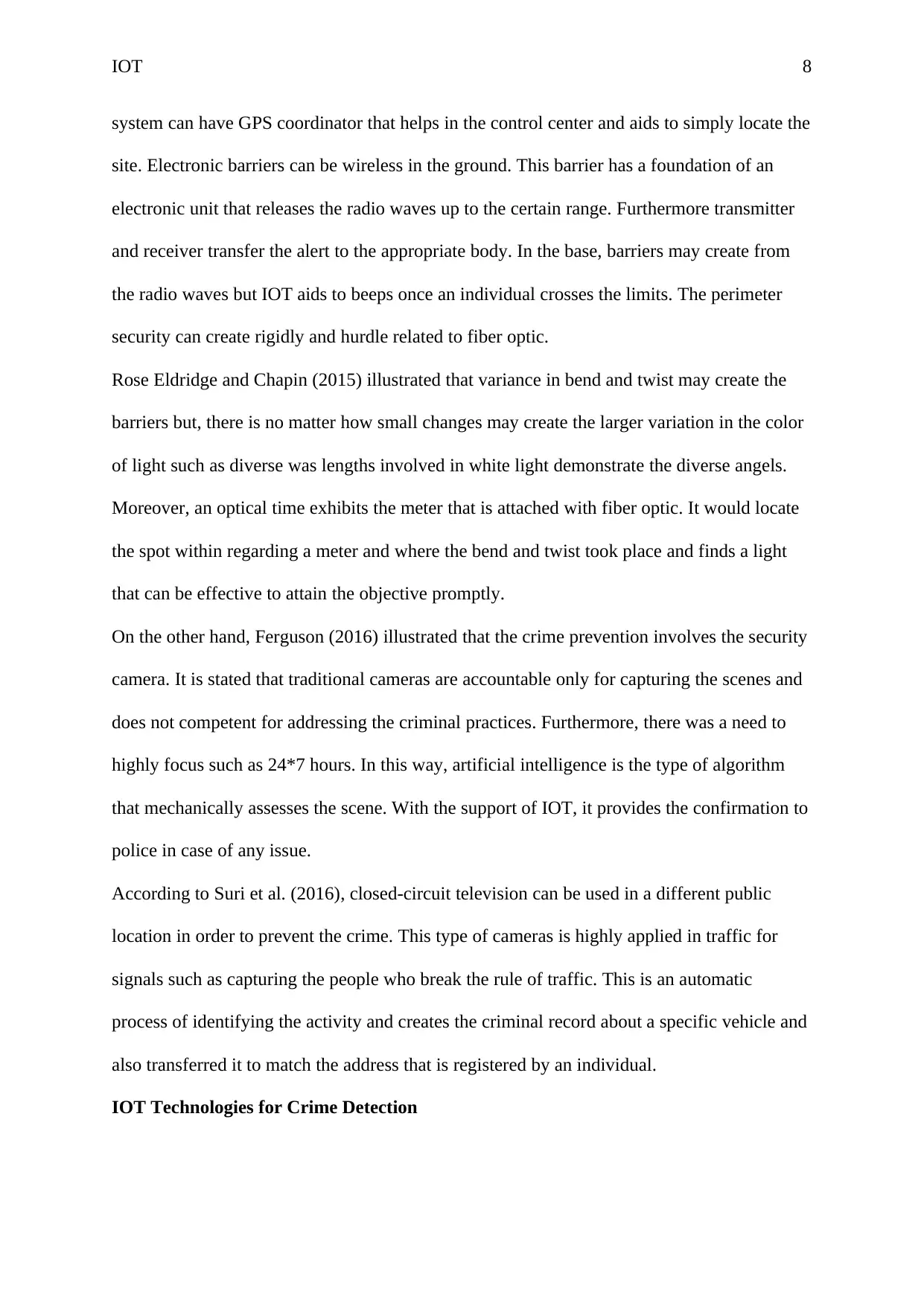
IOT 8
system can have GPS coordinator that helps in the control center and aids to simply locate the
site. Electronic barriers can be wireless in the ground. This barrier has a foundation of an
electronic unit that releases the radio waves up to the certain range. Furthermore transmitter
and receiver transfer the alert to the appropriate body. In the base, barriers may create from
the radio waves but IOT aids to beeps once an individual crosses the limits. The perimeter
security can create rigidly and hurdle related to fiber optic.
Rose Eldridge and Chapin (2015) illustrated that variance in bend and twist may create the
barriers but, there is no matter how small changes may create the larger variation in the color
of light such as diverse was lengths involved in white light demonstrate the diverse angels.
Moreover, an optical time exhibits the meter that is attached with fiber optic. It would locate
the spot within regarding a meter and where the bend and twist took place and finds a light
that can be effective to attain the objective promptly.
On the other hand, Ferguson (2016) illustrated that the crime prevention involves the security
camera. It is stated that traditional cameras are accountable only for capturing the scenes and
does not competent for addressing the criminal practices. Furthermore, there was a need to
highly focus such as 24*7 hours. In this way, artificial intelligence is the type of algorithm
that mechanically assesses the scene. With the support of IOT, it provides the confirmation to
police in case of any issue.
According to Suri et al. (2016), closed-circuit television can be used in a different public
location in order to prevent the crime. This type of cameras is highly applied in traffic for
signals such as capturing the people who break the rule of traffic. This is an automatic
process of identifying the activity and creates the criminal record about a specific vehicle and
also transferred it to match the address that is registered by an individual.
IOT Technologies for Crime Detection
system can have GPS coordinator that helps in the control center and aids to simply locate the
site. Electronic barriers can be wireless in the ground. This barrier has a foundation of an
electronic unit that releases the radio waves up to the certain range. Furthermore transmitter
and receiver transfer the alert to the appropriate body. In the base, barriers may create from
the radio waves but IOT aids to beeps once an individual crosses the limits. The perimeter
security can create rigidly and hurdle related to fiber optic.
Rose Eldridge and Chapin (2015) illustrated that variance in bend and twist may create the
barriers but, there is no matter how small changes may create the larger variation in the color
of light such as diverse was lengths involved in white light demonstrate the diverse angels.
Moreover, an optical time exhibits the meter that is attached with fiber optic. It would locate
the spot within regarding a meter and where the bend and twist took place and finds a light
that can be effective to attain the objective promptly.
On the other hand, Ferguson (2016) illustrated that the crime prevention involves the security
camera. It is stated that traditional cameras are accountable only for capturing the scenes and
does not competent for addressing the criminal practices. Furthermore, there was a need to
highly focus such as 24*7 hours. In this way, artificial intelligence is the type of algorithm
that mechanically assesses the scene. With the support of IOT, it provides the confirmation to
police in case of any issue.
According to Suri et al. (2016), closed-circuit television can be used in a different public
location in order to prevent the crime. This type of cameras is highly applied in traffic for
signals such as capturing the people who break the rule of traffic. This is an automatic
process of identifying the activity and creates the criminal record about a specific vehicle and
also transferred it to match the address that is registered by an individual.
IOT Technologies for Crime Detection
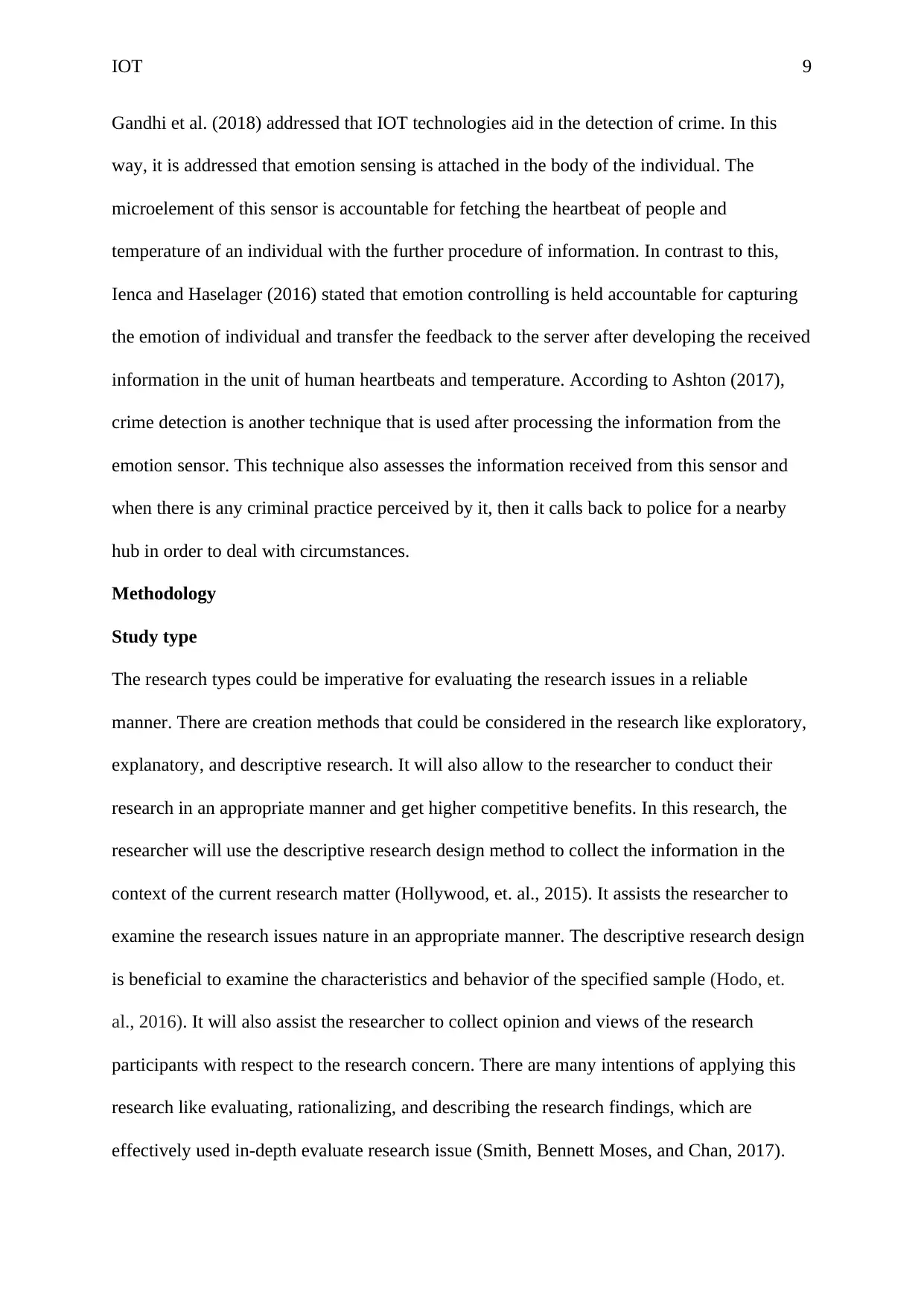
IOT 9
Gandhi et al. (2018) addressed that IOT technologies aid in the detection of crime. In this
way, it is addressed that emotion sensing is attached in the body of the individual. The
microelement of this sensor is accountable for fetching the heartbeat of people and
temperature of an individual with the further procedure of information. In contrast to this,
Ienca and Haselager (2016) stated that emotion controlling is held accountable for capturing
the emotion of individual and transfer the feedback to the server after developing the received
information in the unit of human heartbeats and temperature. According to Ashton (2017),
crime detection is another technique that is used after processing the information from the
emotion sensor. This technique also assesses the information received from this sensor and
when there is any criminal practice perceived by it, then it calls back to police for a nearby
hub in order to deal with circumstances.
Methodology
Study type
The research types could be imperative for evaluating the research issues in a reliable
manner. There are creation methods that could be considered in the research like exploratory,
explanatory, and descriptive research. It will also allow to the researcher to conduct their
research in an appropriate manner and get higher competitive benefits. In this research, the
researcher will use the descriptive research design method to collect the information in the
context of the current research matter (Hollywood, et. al., 2015). It assists the researcher to
examine the research issues nature in an appropriate manner. The descriptive research design
is beneficial to examine the characteristics and behavior of the specified sample (Hodo, et.
al., 2016). It will also assist the researcher to collect opinion and views of the research
participants with respect to the research concern. There are many intentions of applying this
research like evaluating, rationalizing, and describing the research findings, which are
effectively used in-depth evaluate research issue (Smith, Bennett Moses, and Chan, 2017).
Gandhi et al. (2018) addressed that IOT technologies aid in the detection of crime. In this
way, it is addressed that emotion sensing is attached in the body of the individual. The
microelement of this sensor is accountable for fetching the heartbeat of people and
temperature of an individual with the further procedure of information. In contrast to this,
Ienca and Haselager (2016) stated that emotion controlling is held accountable for capturing
the emotion of individual and transfer the feedback to the server after developing the received
information in the unit of human heartbeats and temperature. According to Ashton (2017),
crime detection is another technique that is used after processing the information from the
emotion sensor. This technique also assesses the information received from this sensor and
when there is any criminal practice perceived by it, then it calls back to police for a nearby
hub in order to deal with circumstances.
Methodology
Study type
The research types could be imperative for evaluating the research issues in a reliable
manner. There are creation methods that could be considered in the research like exploratory,
explanatory, and descriptive research. It will also allow to the researcher to conduct their
research in an appropriate manner and get higher competitive benefits. In this research, the
researcher will use the descriptive research design method to collect the information in the
context of the current research matter (Hollywood, et. al., 2015). It assists the researcher to
examine the research issues nature in an appropriate manner. The descriptive research design
is beneficial to examine the characteristics and behavior of the specified sample (Hodo, et.
al., 2016). It will also assist the researcher to collect opinion and views of the research
participants with respect to the research concern. There are many intentions of applying this
research like evaluating, rationalizing, and describing the research findings, which are
effectively used in-depth evaluate research issue (Smith, Bennett Moses, and Chan, 2017).
⊘ This is a preview!⊘
Do you want full access?
Subscribe today to unlock all pages.

Trusted by 1+ million students worldwide
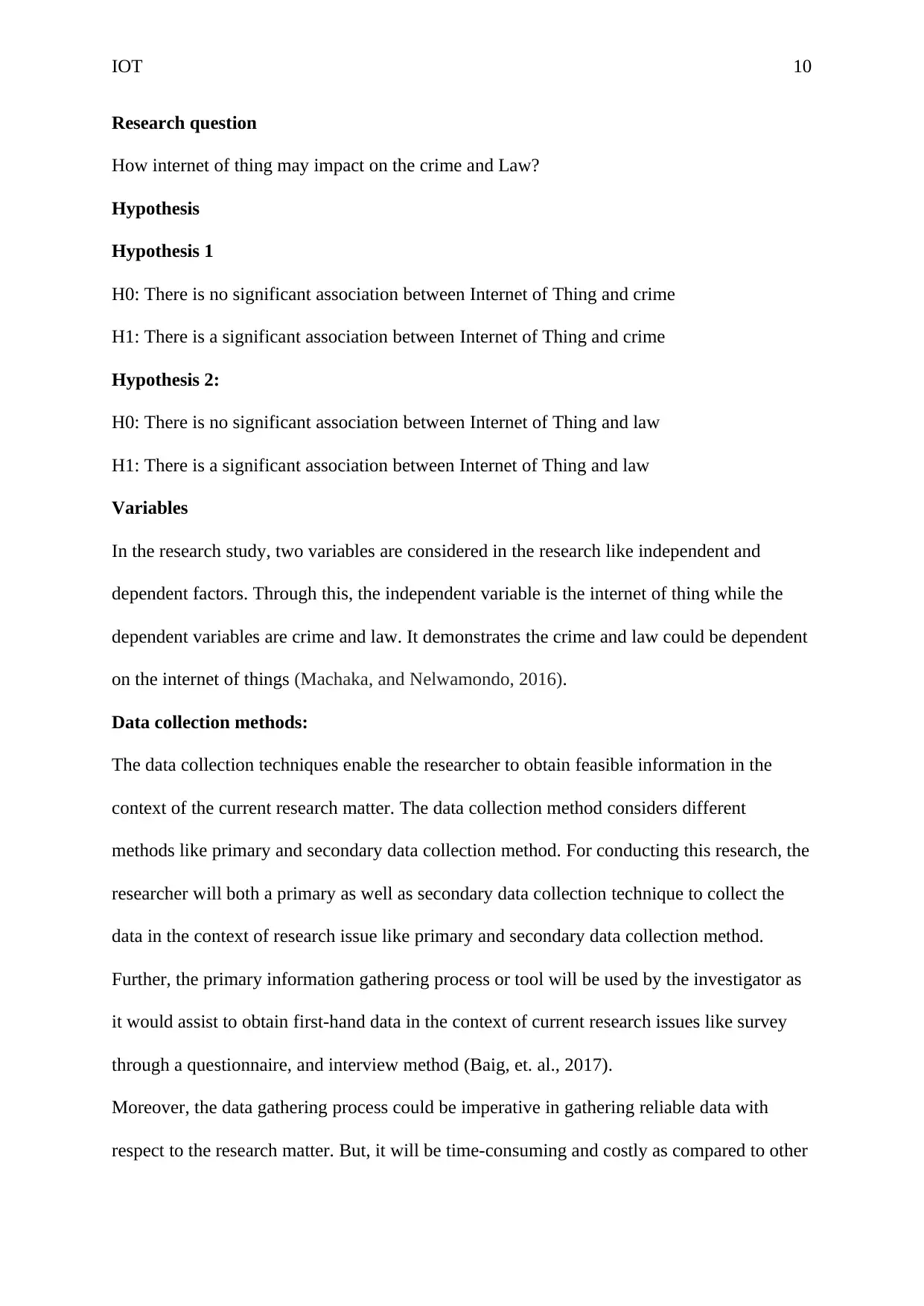
IOT 10
Research question
How internet of thing may impact on the crime and Law?
Hypothesis
Hypothesis 1
H0: There is no significant association between Internet of Thing and crime
H1: There is a significant association between Internet of Thing and crime
Hypothesis 2:
H0: There is no significant association between Internet of Thing and law
H1: There is a significant association between Internet of Thing and law
Variables
In the research study, two variables are considered in the research like independent and
dependent factors. Through this, the independent variable is the internet of thing while the
dependent variables are crime and law. It demonstrates the crime and law could be dependent
on the internet of things (Machaka, and Nelwamondo, 2016).
Data collection methods:
The data collection techniques enable the researcher to obtain feasible information in the
context of the current research matter. The data collection method considers different
methods like primary and secondary data collection method. For conducting this research, the
researcher will both a primary as well as secondary data collection technique to collect the
data in the context of research issue like primary and secondary data collection method.
Further, the primary information gathering process or tool will be used by the investigator as
it would assist to obtain first-hand data in the context of current research issues like survey
through a questionnaire, and interview method (Baig, et. al., 2017).
Moreover, the data gathering process could be imperative in gathering reliable data with
respect to the research matter. But, it will be time-consuming and costly as compared to other
Research question
How internet of thing may impact on the crime and Law?
Hypothesis
Hypothesis 1
H0: There is no significant association between Internet of Thing and crime
H1: There is a significant association between Internet of Thing and crime
Hypothesis 2:
H0: There is no significant association between Internet of Thing and law
H1: There is a significant association between Internet of Thing and law
Variables
In the research study, two variables are considered in the research like independent and
dependent factors. Through this, the independent variable is the internet of thing while the
dependent variables are crime and law. It demonstrates the crime and law could be dependent
on the internet of things (Machaka, and Nelwamondo, 2016).
Data collection methods:
The data collection techniques enable the researcher to obtain feasible information in the
context of the current research matter. The data collection method considers different
methods like primary and secondary data collection method. For conducting this research, the
researcher will both a primary as well as secondary data collection technique to collect the
data in the context of research issue like primary and secondary data collection method.
Further, the primary information gathering process or tool will be used by the investigator as
it would assist to obtain first-hand data in the context of current research issues like survey
through a questionnaire, and interview method (Baig, et. al., 2017).
Moreover, the data gathering process could be imperative in gathering reliable data with
respect to the research matter. But, it will be time-consuming and costly as compared to other
Paraphrase This Document
Need a fresh take? Get an instant paraphrase of this document with our AI Paraphraser
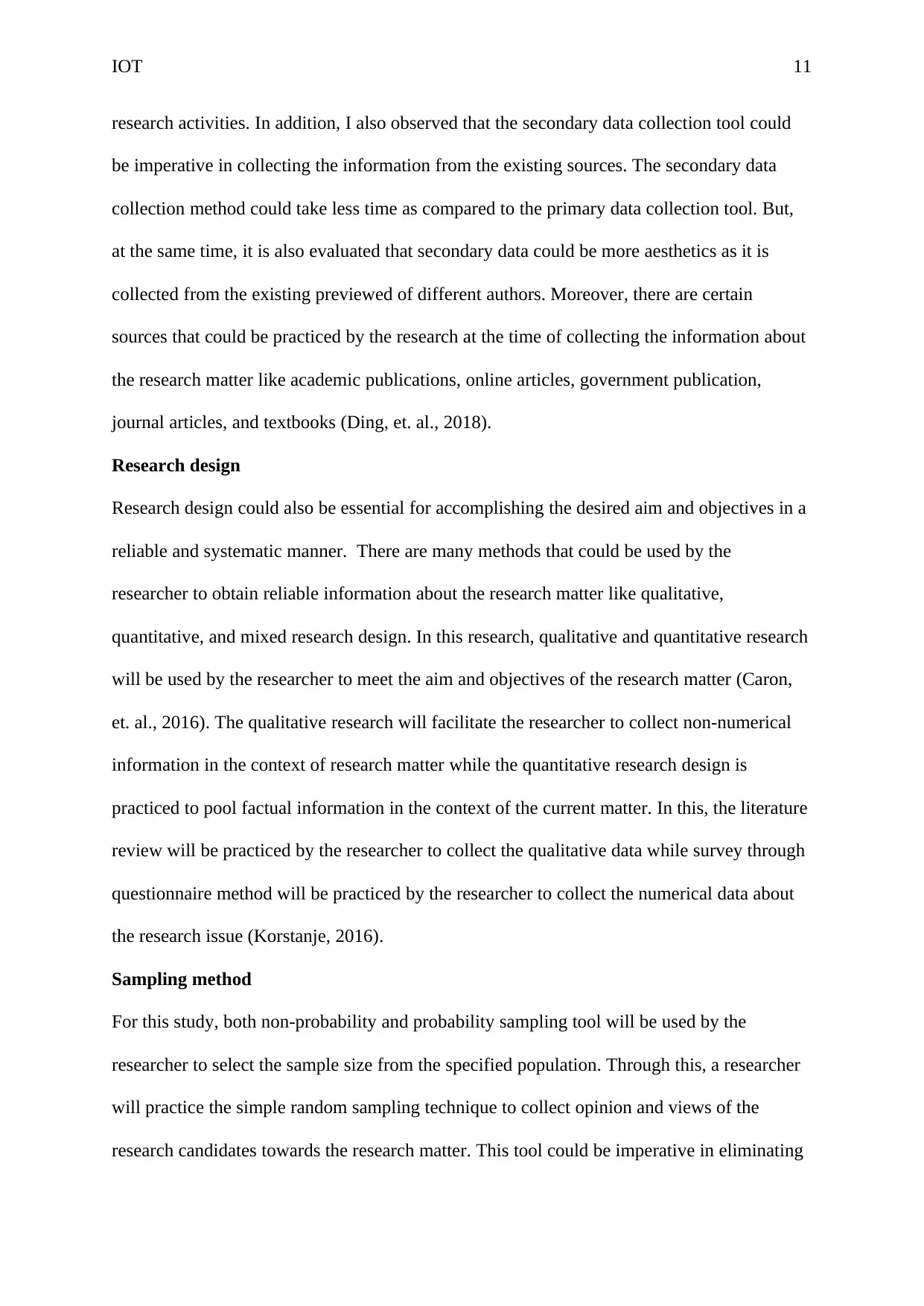
IOT 11
research activities. In addition, I also observed that the secondary data collection tool could
be imperative in collecting the information from the existing sources. The secondary data
collection method could take less time as compared to the primary data collection tool. But,
at the same time, it is also evaluated that secondary data could be more aesthetics as it is
collected from the existing previewed of different authors. Moreover, there are certain
sources that could be practiced by the research at the time of collecting the information about
the research matter like academic publications, online articles, government publication,
journal articles, and textbooks (Ding, et. al., 2018).
Research design
Research design could also be essential for accomplishing the desired aim and objectives in a
reliable and systematic manner. There are many methods that could be used by the
researcher to obtain reliable information about the research matter like qualitative,
quantitative, and mixed research design. In this research, qualitative and quantitative research
will be used by the researcher to meet the aim and objectives of the research matter (Caron,
et. al., 2016). The qualitative research will facilitate the researcher to collect non-numerical
information in the context of research matter while the quantitative research design is
practiced to pool factual information in the context of the current matter. In this, the literature
review will be practiced by the researcher to collect the qualitative data while survey through
questionnaire method will be practiced by the researcher to collect the numerical data about
the research issue (Korstanje, 2016).
Sampling method
For this study, both non-probability and probability sampling tool will be used by the
researcher to select the sample size from the specified population. Through this, a researcher
will practice the simple random sampling technique to collect opinion and views of the
research candidates towards the research matter. This tool could be imperative in eliminating
research activities. In addition, I also observed that the secondary data collection tool could
be imperative in collecting the information from the existing sources. The secondary data
collection method could take less time as compared to the primary data collection tool. But,
at the same time, it is also evaluated that secondary data could be more aesthetics as it is
collected from the existing previewed of different authors. Moreover, there are certain
sources that could be practiced by the research at the time of collecting the information about
the research matter like academic publications, online articles, government publication,
journal articles, and textbooks (Ding, et. al., 2018).
Research design
Research design could also be essential for accomplishing the desired aim and objectives in a
reliable and systematic manner. There are many methods that could be used by the
researcher to obtain reliable information about the research matter like qualitative,
quantitative, and mixed research design. In this research, qualitative and quantitative research
will be used by the researcher to meet the aim and objectives of the research matter (Caron,
et. al., 2016). The qualitative research will facilitate the researcher to collect non-numerical
information in the context of research matter while the quantitative research design is
practiced to pool factual information in the context of the current matter. In this, the literature
review will be practiced by the researcher to collect the qualitative data while survey through
questionnaire method will be practiced by the researcher to collect the numerical data about
the research issue (Korstanje, 2016).
Sampling method
For this study, both non-probability and probability sampling tool will be used by the
researcher to select the sample size from the specified population. Through this, a researcher
will practice the simple random sampling technique to collect opinion and views of the
research candidates towards the research matter. This tool could be imperative in eliminating
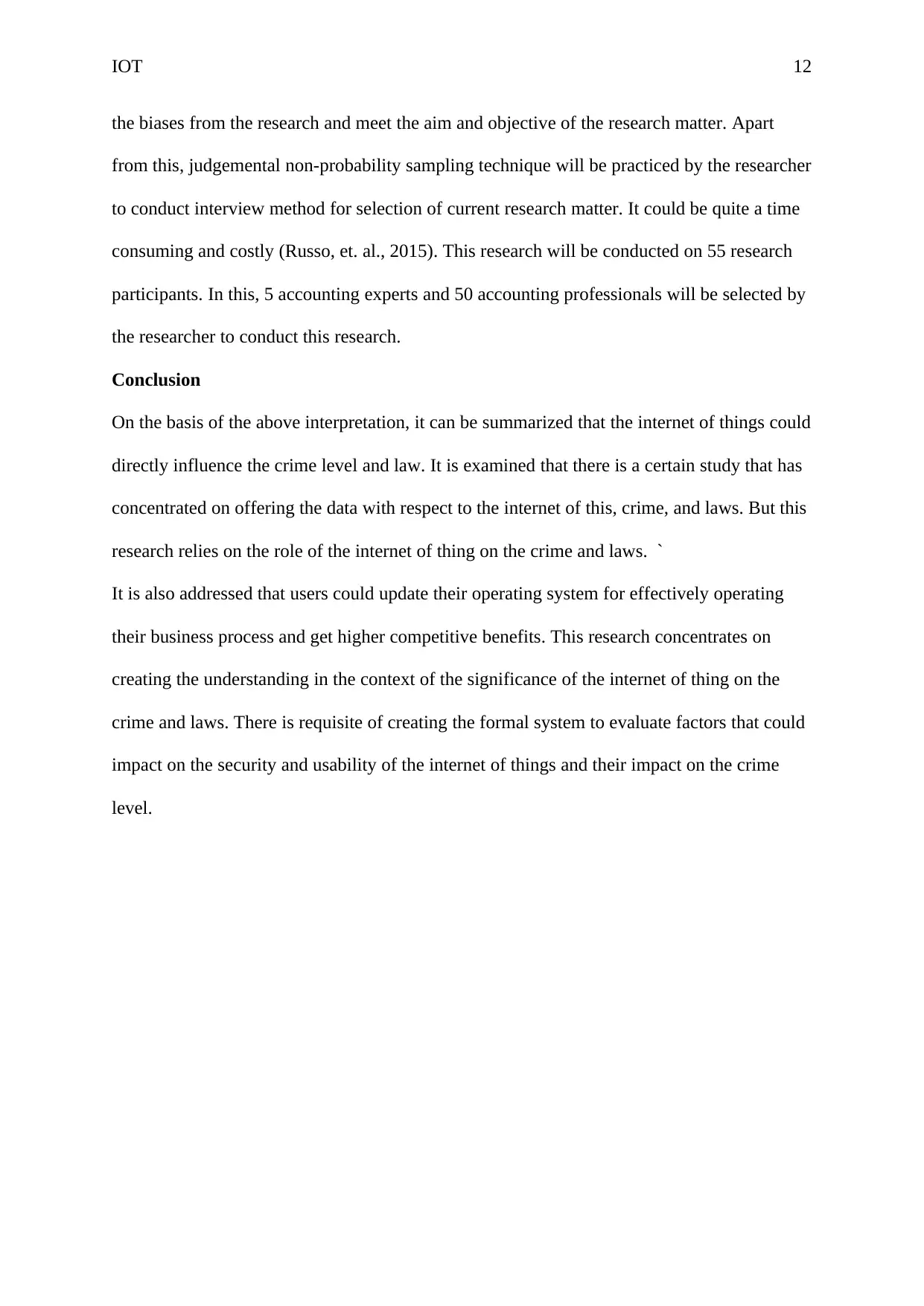
IOT 12
the biases from the research and meet the aim and objective of the research matter. Apart
from this, judgemental non-probability sampling technique will be practiced by the researcher
to conduct interview method for selection of current research matter. It could be quite a time
consuming and costly (Russo, et. al., 2015). This research will be conducted on 55 research
participants. In this, 5 accounting experts and 50 accounting professionals will be selected by
the researcher to conduct this research.
Conclusion
On the basis of the above interpretation, it can be summarized that the internet of things could
directly influence the crime level and law. It is examined that there is a certain study that has
concentrated on offering the data with respect to the internet of this, crime, and laws. But this
research relies on the role of the internet of thing on the crime and laws. `
It is also addressed that users could update their operating system for effectively operating
their business process and get higher competitive benefits. This research concentrates on
creating the understanding in the context of the significance of the internet of thing on the
crime and laws. There is requisite of creating the formal system to evaluate factors that could
impact on the security and usability of the internet of things and their impact on the crime
level.
the biases from the research and meet the aim and objective of the research matter. Apart
from this, judgemental non-probability sampling technique will be practiced by the researcher
to conduct interview method for selection of current research matter. It could be quite a time
consuming and costly (Russo, et. al., 2015). This research will be conducted on 55 research
participants. In this, 5 accounting experts and 50 accounting professionals will be selected by
the researcher to conduct this research.
Conclusion
On the basis of the above interpretation, it can be summarized that the internet of things could
directly influence the crime level and law. It is examined that there is a certain study that has
concentrated on offering the data with respect to the internet of this, crime, and laws. But this
research relies on the role of the internet of thing on the crime and laws. `
It is also addressed that users could update their operating system for effectively operating
their business process and get higher competitive benefits. This research concentrates on
creating the understanding in the context of the significance of the internet of thing on the
crime and laws. There is requisite of creating the formal system to evaluate factors that could
impact on the security and usability of the internet of things and their impact on the crime
level.
⊘ This is a preview!⊘
Do you want full access?
Subscribe today to unlock all pages.

Trusted by 1+ million students worldwide
1 out of 20
Related Documents
Your All-in-One AI-Powered Toolkit for Academic Success.
+13062052269
info@desklib.com
Available 24*7 on WhatsApp / Email
![[object Object]](/_next/static/media/star-bottom.7253800d.svg)
Unlock your academic potential
Copyright © 2020–2025 A2Z Services. All Rights Reserved. Developed and managed by ZUCOL.

